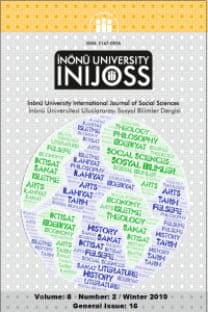ESTETİK VE GERÇEKLİK: JOHN KEATS SANATINDA SÜREKLİ GERÇEKÇİLİK
Estetik, Gerçeklik, Gerçekçilik, Nesne-Yönelimli Ontoloji
AESTHETIC AND REALITY: PERPETUAL REALISM IN THE ART OF JOHN KEATS
Aesthetic, Reality, Object-Oriented Ontology, Realism,
___
Abrams, M.H.(Ed.)( 1999). A Glossary of Literary Terms. (7th ed). Thompson Learning.Adorno, W. T.(1997). Aesthetic Theory ( Vol.88). G. Adolfo & R. Tiedemann (Eds), R. Hullot Kentor (Trans.). USA: University of Minnesota.
Comfort, K.( 2008). Introduction. Art and Life in Aestheticism: De-Humanizing and Re-Humanizing Art, the Artist, and the Artistic Receptor (pp. 1-21). Palgrave Macmillan.
Cook, E. (1990).Introduction. John Keats: The Major Works (pp. xvii-xxviii). UK: Oxford University Press.
Harman, G.(2018). Object Oriented Ontology: A New Theory Of Everything. UK: Pelican Books.
Jack, I. (1967). Keats and the Mirror of Art. UK: Oxford University Press.
Kabitoglou, D. E. (1992). Adapting Philosophy to Literature: The case of John Keats. Studies in Philology, 89 (1), 115-136. JSTOR, www.jstor.rg/stable/4174413.
Kant, I. (2001). Basic Writings of Kant. A. W. Wood (Ed). Modern Library.
Keats, J. (1990). John Keats: The Major Works. E. Cook (Ed). UK: Oxford University Press.
Khalip, J. (2006).Virtual Conduct: Disinterested Agency in Hazlitt and Keats. ELH, 73 (4), 885-912. JSTOR, www.jstor.rg/stable/30030042.
Kroeber, K.( 1963 ).The New Humanism of Keats’s Odes. Proceedings of the American Philosophical Society, 107 (3), 263-271. JSTOR, www.jstor.rg/stable/985583.
Leighton, A. (2007). On Form: Poetry, Aestheticism, and the Legacy of a Word. UK: Oxford University Press.
McGrath, B.(2011). Keats for Beginners. Studies in Romanticism, 50 (2), 351-372. JSTOR, www.jstor.rg/stable/23056042.
Moore, C. (2012).Socrates Psychagogos (Birds 1555, Phaedrus 261a7). Socratica III, St. F. Rossetti (Ed), 1-19.
O’Rourke, J. (1987). Persona and Voice in the “Ode on a Grecian Urn.” Studies in Romanticism, 26 (1), 27-48. JSTOR, www.jstor.rg/stable/25600633.
Ortega Y. Gasset, J.(1975). P. Silver (Trans.), An Essay in Esthetics by Way of a Preface. In Phenomenology and Art (pp. 127-50). New York: Norton.
Phinney, A. W. (1991). Keats in the Museum: Between Aesthetics and History. The Journal of English and Germanic Philology, 90 (2),208-229. JSTOR, www.jstor.rg/stable/27710485.
Plato (2008). Phaedrus, B. Jowett (Trans.). Project Gutenberg, www.Gutenberg.org/1/6/3/1636/.
---. ( 2015). Φαίδρος, http://el.wikisource.org/w/index.php?title= Φαίδρος&oldid=55461.
--- .(2008). Republic, B. Jowett (Trans.). Project Gutenberg, www.Gutenberg.org/1/4/9/1497/.
Pyle, F. (2003). Kindling and Ash: Radical Aestheticism in Keats and Shelley. Studies in Romanticism, 42 (4), 427-259. JSTOR, www.jstor.rg/stable/25601642.
Rajan, T. (1998). Keats, Poetry, and “The Absence of the Work”. Modern Philology, 95 (3), 334-351. JSTOR, www.jstor.rg/stable/438880.
Salle, J.C. (1972). The Pious Frauds of Art: A Reading of the “Ode on a Grecian Urn”. Studies in Romanticism, 11 (2), 79-93. JSTOR, www.jstor.rg/stable/25599836.
Spitzer, L. (1962). “Ode on a Grecian Urn” or, Content vs. Metagrammar. Essays on English and American Literature (pp. 67-97). Princeton Legacy Library.
Stillinger, J. (1997). Multiple Readers, Multiple Texts, Multiple Keats. The Journal of English and Germanic Philology, 96 (4), 545-566. JSTOR, www.jstor.rg/stable/27711572.
Vendler, H. (1973). The Experimental Beginnings of Keats’s Odes. Studies in Romanticism, 12 (3), 592-606. JSTOR, www.jstor.rg/stable/25601083.25599889.
Williams, M. H. (2010). The Aesthetic Development: The Poetic Spirit of Psychoanalysis. Karnac Books.
Wood, W. A. (2001). Introduction. Basic Writings of Kant (pp. xvi-xxviii). Modern Library.
- ISSN: 2147-0936
- Yayın Aralığı: Yılda 2 Sayı
- Yayıncı: İnönü Üniversitesi
AKIL VE İNSANLIĞIN YÜCELTILMESI: WILLIAM BLAKE
TÜRKÜLERİMİZDEKİ METRONOM HIZI DEĞİŞKENİNİN DİNLEYİCİDE MEYDANA GETİREBİLECEĞİ ALGISAL FARKLILIKLAR
İMÂMİYYE ŞÎASI KAYNAKLARINDA HZ. MUHAMMED’İN ÖLÜMÜ İLE İLGİLİ SPEKÜLASYONLAR
ESTETİK VE GERÇEKLİK: JOHN KEATS SANATINDA SÜREKLİ GERÇEKÇİLİK
İNGİLİZ ORYANTALİST E. H. PALMER ve ARAPÇA DERS KİTAPLARI
MEHMED MİHRÎ EFENDİ’NİN SULTÂN ABDULHAMÎD’İN CÜLÛSUNA YAZDIĞI ŞİİRLER
KURUMSAL YÖNETİMİN PORTFÖY PERFORMANSI ÜZERİNDEKİ ETKİSİ: BORSA İSTANBUL ÖRNEĞİ
Mustafa KISAKÜREK, Seren AYDINGÜLÜ SAKALSIZ
OKUL YÖNETİCİLERİNİN ULUSAL KÜLTÜR ALGILARININ LİDERLİK TARZLARINA ETKİSİNİN İNCELENMESİ
Hakan BİLGÜTAY, Hanifi Murat MUTLU
